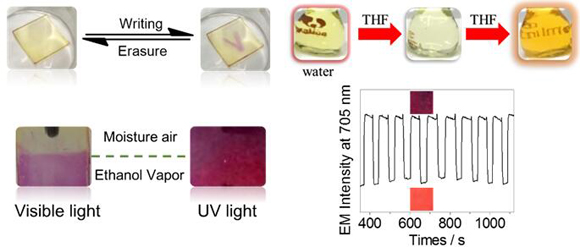A research work was published by Dr. Yongguang Li’s group: Supramolecular self-assembly and dual-switch vapochromic, vapoluminescent, and resistive memory behaviors of amphiphilic platinum(II) complexes
Source: School of Chemistry
Written by: School of Chemistry
Edited by: Wang Dongmei
Vapochromic and vapoluminescent materials as sensor devices for detecting vapor from volatile organic compounds (VOC) are widely used in our living environments. It has been demonstrated that these materials based on d6, d8or d10metal complexes are mostly relevant to intermolecular non-covalent weak interactions. However, the slow response and complicated procedures for the activation/recovery processes of a number of vapochromic systems of metal complexes, together with the rather poor selectivity and reproducibility, have limited their practical applications. As a result, it is important to develop highly sensitive materials with good selectivity to specific species, fast response, good reversibility and easy device fabrication.
Recently, Dr. Yongguang Li’s research group (School of Chemistry, Sun Yat-sen University) developed an interesting class of amphiphilic platinum(II) complexes exhibiting fast response and high selectivity toward alcohol and water vapors, accompanied with drastic color and luminescence changes. Based on this property, rapid writing-erasure processes have been realized on the film prepared from the vapochromic material. Reversible and dramatic color and luminescence changes also provide a promising candidate for potential applications as luminescent probes to monitor alcohol and humidity. In collaboration with Prof. Vivian Wing-Wah Yam (Department of Chemistry, The University of Hong Kong), resistive memory devices was fabricated and showed stable and promising binary memory performance.

This work has been published on J. Am. Chem. Soc. (DOI: 10.1021/jacs.7b07638).
This work was supported by the National Natural Science Foundation of China and the Fundamental Research Funds for the Central Universities. Lehn Institute of Functional Materials is also gratefully acknowledged.
Link to the paper: http://pubs.acs.org/doi/10.1021/jacs.7b07638
